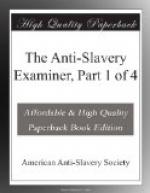as he pleased, he was not to be punished, if he destroyed
it. Whether the servant died under the master’s
hand, or after a day or two, he was equally
his property, and the objector admits that in the
first case the master is to be “surely
punished” for destroying his own property!
The other inference is, that since the continuance
of a day or two, cleared the master of intent to
kill, the loss of the slave would be a sufficient
punishment for inflicting the injury which caused his
death. This inference makes the Mosaic law false
to its own principles. A pecuniary loss
was no part of the legal claim, where a person took
the life of another. In such case, the
law spurned money, whatever the sum. God would
not cheapen human life, by balancing it with such a
weight. “Ye shall take NO SATISFACTION
for the life of a murderer, but he shall surely be
put to death.” Num. xxxv. 31. Even
in excusable homicide, where an axe slipped from the
helve and killed a man, no sum of money availed to
release from confinement in the city of refuge, until
the death of the High Priest. Numb. xxxv. 32.
The doctrine that the loss of the servant would be
a penalty adequate to the desert of the master,
admits his guilt and his desert of some
punishment, and it prescribes a kind of punishment,
rejected by the law in all cases where man took the
life of man, whether with or without the intent to
kill. In short, the objector annuls an integral
part of the system—makes a new law,
and coolly metes out such penalty as he thinks fit.
Divine legislation revised and improved! The
master who struck out his servant’s tooth, whether
intentionally or not, was required to set him free.
The pecuniary loss to the master was the same
as though he had killed him. Look at the two
cases. A master beats his servant so that he
dies of his wounds; another accidentally strikes out
his servant’s tooth,—the pecuniary
loss of both cases is the same. If the loss
of the slave’s services is punishment sufficient
for the crime of killing him, would God command
the same punishment for the accidental
knocking out of a tooth? Indeed, unless the
injury was done inadvertantly, the loss of
the servant’s services was only a part
of the punishment—mere reparation to the
individual for injury done; the main
punishment, that strictly judicial, was reparation
to the community. To set the servant free,
and thus proclaim his injury, his right to redress,
and the measure of it—answered not the ends
of public justice. The law made an example
of the offender. That “those that remain
might hear and fear.” “If a man cause
a blemish in his neighbor, as he hath done, so shall
it be done unto him. Breach for breach, eye for
eye, tooth for tooth. Ye shall have one manner
of law as well for the STRANGER as for one of your
own country.” Lev xxiv. 19, 20, 22.
Finally, if a master smote out his servant’s
tooth the law smote out his tooth—thus
redressing the public wrong; and it cancelled
the servant’s obligation to the master, thus
giving some compensation for the injury done, and
exempting him form perilous liabilities in future.




